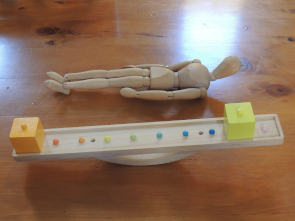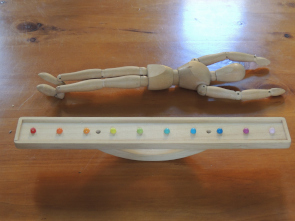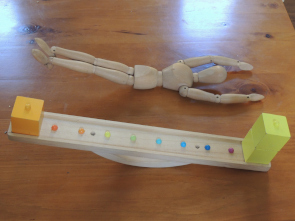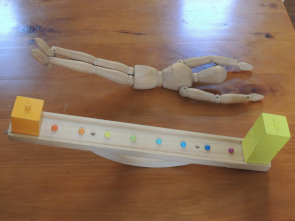I love the Pilates Roll Up as an exercise. It may be I love it because I can do it, because I know a lot of clients who hate it, because they can’t do it. Good thing our job as instructors is taking people who can’t do something and give them all the skills and strengths to be able to do it.
So, when it comes to the Pilates Roll Up, why can’t people do it? It’s a question that I hear a lot from student teachers. “My client can’t do a Roll Up, what should I do with them?” As I have said before, these questions are really loaded, and difficult to answer without a body in front of you. If you don’t know what a person is doing, you really can’t tell what they are doing wrong (or right for that matter.)
This leads us to the question: What things do people do wrong in the Pilates Roll Up? And how can we fix them?
I’d like to start this conversation with a look at the physics of the motion. In the end, whatever we do is limited or defined by physics- we just can’t avoid it.
The Roll Up is a great example of equilibrium and leverage. We have a human body that is laid out, with a fulcrum (a point where the body rotates around) and weight on either side of the fulcrum. This fulcrum is at the centre of gravity/ centre of mass of our body. This point will be in different places as we move our body through space, particularly where our arms end up. For simplicity, we can say that this point is roughly in the lower part of the lumbar spine (but remember- it’s different from person-to-person, and different as the shape of our body changes). This gives us a situation much like a see-saw (teeter totter), with a balance point in the middle, and a lever arm on each side.
At this point in time, if we were to balance the body at the fulcrum (COG), it would balance nicely. As we Roll Up, we do our best to change the weight distribution of the body in order to execute the exercise without fighting physics. We shift weight from the head end of the fulcrum to the leg end of the fulcrum and just like magic we pop up into a seated position. Without shifting weight from one side to the other, we remain in a state of balance, i.e. the starting point. It’s how we attempt to shift this weight that determines how effectively we execute the exercise.
Here’s where things go wrong!
Here are two common things you will see in a Pilates Roll Up and what is happening from a physics perspective:
1) Feet are lifting up.
This is the most common issue you will see in a Roll Up, and can have a few reasons behind it. When we said that the body balances on a fulcrum point, we don’t actually balance on a fulcrum point per se. It’s generally a broad, flat area between and including the lower ribs and pelvis. This means that the body can’t “teeter” around its fulcrum, but instead has a base of support where the upper body is heavier than the lower body and will anchor down while the feet lift up. This happens for a number of reasons:
a) People are relying on their hip flexors to bring the body up.
If your client spends loads of time in the gym with their feet anchored down while they do sit ups, this is a common strategy you will see. With the feet anchored down, the strong hip flexors are able to kick in and act in reverse origin and insertion, and lift the body up. When the feet aren’t anchored down, the legs will lift because the upper body end is heavier and therefore “anchored down”, resulting in hip flexion and leg lift.
b) The arms are lingering overhead or up to the ceiling.
This just lengthens the lever too much and results in the same anchoring down of the torso. The torque (rotational force around the axis of rotation/ fulcrum) of one side is less than the other: Torque (T) = Force (F) x distance away from axis (d) if you increase the distance on one side, you get greater force on that side, and an anchoring down. T(left)= F x d. T(right)= F x 2d will result in twice as much torque on the right side.
c) Lack of spinal movement.
This will do the same as the lingering arms- just maintain a long lever length at the torso end, anchoring it down, and providing too much force down for the torso to lift without lifting the legs.
d) Improper sequencing.

Same lever length issue occurs. The spine needs to curl into flexion in order to shift the weight towards the fulcrum, decrease the distance away from the axis of rotation, and decrease the torque on the torso side. In order to do this the sequence must begin at the head, take the furthest point away from the axis and move it closer, then take the second closest point (neck), then third (shoulders), etc. incrementally decreasing the torque, and allowing the feet to stay down. If the sequence begins with the hip flexors (see dominance of hip flexors in point a) ), the torque isn’t balanced, and the feet flick up.
2) Nothing is happening.
Yep, I have seen this happen. Head lifts and then… nothing. There’s plenty of reasons behind this but here are a couple:
a) There is a structural problem.
If the spine doesn’t move (too stiff, has titanium rods in it), then the weight shifting can’t occur. If it’s an honest structural problem that is unchangeable, then we just need to admit defeat and suggest that this exercise is just not for them. There are other ways to work these people that will be more effective. If it’s just a stiff spine that is structural but can be altered, then attack that problem first. There may be a fascial issue and the fascia may need to be worked on. The muscles may be stiff, over-excited or guarding, and that needs to be worked on to get the appropriate amount of mobility before re-attempting the exercise.
b) There isn’t enough strength.
You can’t expect a 2 year old to push over an elephant, they’re just not strong enough. If the client’s spinal and hip flexors aren’t strong enough, then regardless of how much mobility and sequencing you do, they still won’t be able to do the exercise. Just get them stronger.
c) Body dimensions are getting in the way.
If someone is unusually heavy at their shoulders and unusually light at their legs, the distribution of force may prohibit enough weight shift from occurring. The requirement for extra strength to move extra weight and bracing that occurs with extra tissue may make any of the above occur. Conversely, these people work with their body every day, and can be plenty strong enough and could find a strategy to do a Roll Up, so don’t discount someone for that reason.
Once we have a clear picture of what’s going wrong, we only need to build up any deficits (lack of movement, lack of strength, lack of neuromuscular coordination) and integrate it back into a full exercise. For lack of movement in the spine, increase spinal flexibility in all areas. Thoracic mobility can be worked well in exercises like Book Openings where rotation is gained. Lumbar flexibility can be achieved with exercises like Bridges. Cervical spinal movement is easily achieved by sitting upright and flexing/ extending and rotating the neck. Lack of strength is combated with any abdominal exercises, but particularly with exercises that move the body through full range of motion (like the roll up! but think about using spring or elastic strap assistance).
Work on the roll down portion of the exercise, as it works eccentric phasing which is known to increase strength and also allows a full range of motion. Lack of neuromuscular co-ordination may require some mental effort on behalf of your client. Educate them on the sequence you want and see if anything comes out of it. If not, assist them by supporting their back as they do the exercise. Where they jump a part of the sequence, stop them, support them, and get them to relax, forming the correct “shape” (relative position of bones) and get them to move on from there. In doing so, the muscles will be placed in an optimal position to work, and will have a better chance. This will help those sections of muscles that may be weak to work a bit more and get stronger so they can play their part in the kinetic chain.
Hope that helps anyone out there struggling with the Roll Up, and you eventually get to a point where you love it as much as me!
Written by Brad Jamieson for Extend Pilates
This article originally appeared on The Extend Pilates Blog



